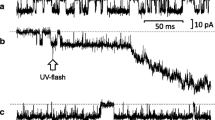Abstract.
Cockroaches have acinar salivary glands. The acini consist of peripheral cells specialized for electrolyte and water transport and central cells contributing proteinaceous components to the saliva. Salivary duct cells probably modify the primary saliva. The acinar cells in Nauphoeta cinerea had been shown to be electrically coupled and dye-coupled. Since intercellular communication via gap junctions between acinar cells is difficult to reconcile with previous findings that dopamine and serotonin selectively stimulate the secretion of either protein-free or protein-rich saliva in Periplaneta americana, we investigated whether dye-coupling occurs between both acinar cell types and between duct cells. We iontophoretically loaded Lucifer yellow into impaled cells and tested for dye-coupling by confocal laser scanning microscopy. We found that: (1) peripheral and central cells within an acinar lobulus of the gland in P. americana are dye-coupled; and (2) salivary duct cells are dye-coupled.
Similar content being viewed by others
Author information
Authors and Affiliations
Additional information
Electronic Publication
Rights and permissions
About this article
Cite this article
Lang, I., Walz, B. Dye-coupling between cells of the salivary glands in the cockroach Periplaneta americana . Cell Tissue Res 298, 357–360 (1999). https://doi.org/10.1007/s004419900108
Received:
Accepted:
Issue Date:
DOI: https://doi.org/10.1007/s004419900108




